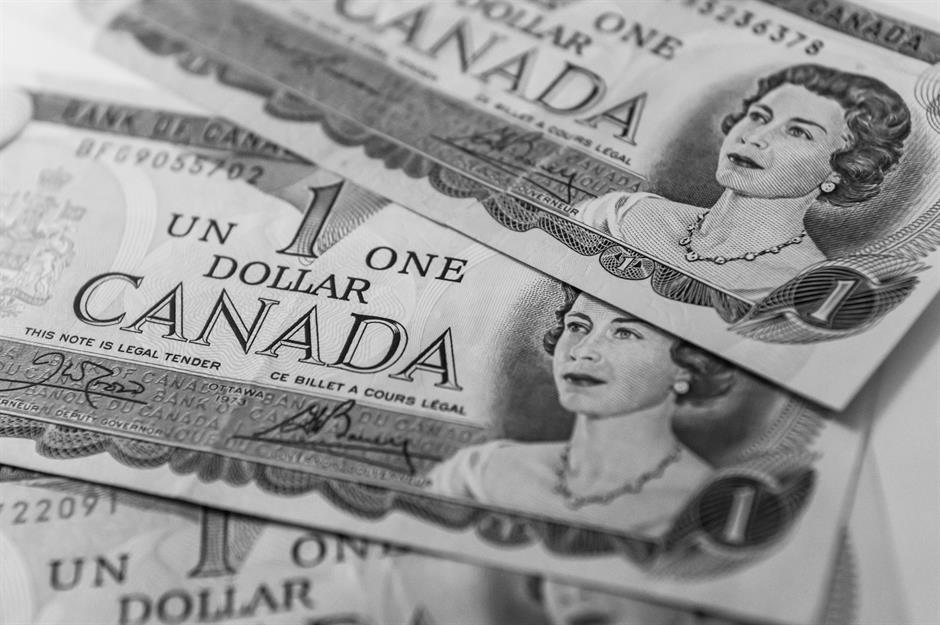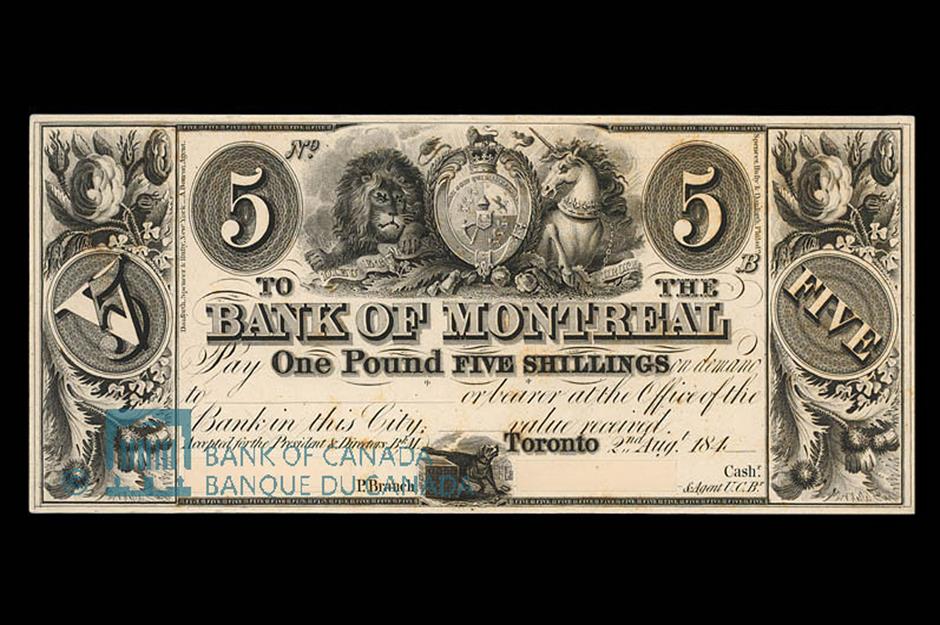How the Canadian dollar has changed over time
The evolution of the loonie
Canada's currency may not have been around for as long as the US dollar, but it's still a good 151 years old. We chart the Canadian dollar's evolution from colonial times to the present day, and from silver coins to polymer notes.
Canadian pound
After years of using French, British and over-stamped Spanish coins, Canada snagged its very first currency in 1841 with the creation of the Canadian pound, which was based on pound sterling. The currency was launched in the Province of Canada, a British colony that formed that year following the union of Upper and Lower Canada.
Currency chaos
Before that, the denizens of the colonies used a chaotic mix of currencies, from Spanish and US dollars, to pound sterling and even playing cards at one point. The first Canadian note, a $20 bill issued by the Bank of Montreal in 1817, was in US currency.
British system
The new Canadian pound was equal to US$4 and just over 16 shillings in pound sterling, and was divided into 240 pence or 20 shillings as per the British system. Early halfpenny and penny coins were made from copper and a variety of notes were issued from sixpence to £25.
Unpopular currency
The currency proved unpopular with the local population who were eager to adopt a simpler and more logical decimal system like the US. In 1851, representatives of the Province of Canada, Nova Scotia and New Brunswick (which were separate at the time) met to discuss the issue.
Moves to decimalisation
Despite calls from the British government to adopt a unit based on the pound sterling called the 'royal', the representatives pushed for decimalisation, setting the stage for the introduction of the Canadian dollar.
Decimal coins
The Province of Canada led the way and issued its first decimal coins in 1858, with Queen Victoria on the obverse. Since then, all Canadian coinage has featured a portrait of the British monarch. The coins were minted in denominations of 1¢, 5¢, 10¢, and 20¢, and made from sterling silver, apart from the 1¢ piece, which was struck in bronze.
Decimalisation spreads
The colony of Nova Scotia and New Brunswick followed suit, going decimal in 1860. Among the other colonies that would come together to form Canada, Newfoundland embraced decimalisation in 1865, followed by British Columbia and Prince Edward Island.
Canadian dollar
In 1867, the Province of Canada merged with Nova Scotia and New Brunswick, and the Dominion of Canada was born. A new currency was established for the new country, the Canadian dollar. British Columbia and Prince Edward island joined the Dominion several years later.
Newfoundland dollar
Newfoundland didn't become part of Canada until 1949 and had its own currency until then, the Newfoundland dollar. The currency was adopted in 1865 and had a higher value than the Canadian dollar until 1894 when a banking crash led to its devaluation and parity.
First coinage
The old colonial coins continued to circulate until 1870 when the Dominion of Canada launched its first coinage. The sterling silver coins, which featured Queen Victoria on the obverse and a maple leaf on the reverse, were issued in denominations of 5¢, 10¢, 25¢ and 50¢. The copper 1¢ coin debuted in 1876.
Royal Canadian Mint
The first coins were struck at the Royal Mint in London. An offshoot of the British institution was established in Ottawa in 1908. It secured autonomy and was renamed the Royal Canadian Mint in 1931. Since 1960, all general circulation coins have been minted at the organisation's ultra-secure facility in Winnipeg.
First banknotes
The first Dominion of Canada banknotes were issued along with the coinage in 1870. The first denominations printed were 25¢, $1, $2, $500 and $1000. The $50 and $100 bills launched in 1872, and a $4 note was released in 1882. The $5 bill didn't enter circulation until 1912.
Chartered banks
As well as government Dominion notes as they were called, paper money was issued by a plethora of chartered banks, which printed a huge variety of notes in denominations starting from $4. The minimum was raised to $5 in 1880.
Currency confusion
Given there were so many different notes in circulation, each with a distinct design, counterfeiting as well as confusion was rife. Even the Dominion notes were forged on an industrial scale. In fact, fake $2 bills from the 1870s outnumber the real deal according to experts.
Currency tweaks
Gold $5 and $10 coins were launched for general circulation in 1912 and 1914, but never issued again. In 1920, lower purity silver 10¢, 25¢ and 50¢ pieces were introduced. The silver 5¢ coin was replaced with a larger nickel coin in 1922. The last 25¢ note, nicknamed the shinplaster, was printed the following year.
Bank of Canada
The Bank of Canada was founded in 1935 in the wake of the Great Depression and granted the exclusive right to print banknotes, ending the confusion of the free banking era. The first Bank of Canada notes launched the following year.
1935 series
The 1935 series introduced denominations of $1, $2, $5, $10, $20, $25, $50, $100, $500 and $1,000. The notes were printed in separate French and English versions, and featured portraits of various royal figures and eminent politicians.
Voyageur dollar
The silver $1 coin debuted in 1935. The so-called Voyageur dollar, which featured an image of a French-Canadian 'voyageur' and an Indigenous man in a canoe, was struck in the precious metal until 1967. Since then, all Canadian coins for general circulation have been made from base metals.
Familiar coins
Newly minted coins entered circulation in 1937 bearing designs by George Kruger-Gray and Emanuel Hahn that are still used today. They include the beaver nickel, the dime featuring the Bluenose schooner and the caribou quarter.
1937 series
A new series of bilingual notes was introduced in 1937, replacing the random royals with King George VI but retaining the politicians – John A MacDonald, Canada's first prime minister, graced the $100 and the $1,000 featured Wilfred Laurier. The $25 and $500 bills were pulled.
Shrinking money
The Canadian dollar has shrunk over time. The supersized early 1¢ coin, which was replaced in 1920, was even bigger than the modern-day quarter, while the 1935 and 1937 series banknotes were slightly larger than contemporary notes, which have measured 152.4 mm x 69.85 mm since 1954.
1952 series
Canada's banknotes were updated again in 1952 to reflect the coronation of a new British monarch and reduced to the size we're familiar with today. The politicians were ditched and a portrait of Queen Elizabeth II by an American engraver graced all new notes, but the image didn't go down well, particularly across the pond...
Devil's Head
The engraver was accused of concealing a depiction of a grinning demon in Her Majesty's hair. As a consequence of the furore, the design was modified the following year and the offending notes were withdrawn. The series has since become known as the Devil's Head series.
1969 series
The next change came in 1969. A series of updated notes was launched to combat fraud, the Scenes of Canada series. As you might imagine, the notes featured vignettes of life in Canada. The Bank of Canada also removed the Queen from the $5, $10, $50 and $100 bills and reintroduced the politicians.
Birds of Canada series
The Birds of Canada series was released in 1986. The banknotes, which depicted emblematic Canadian birds like the snowy owl, osprey and Canada goose on the reverse, boasted a number of enhanced security features.
Loonie debuts
In 1987, the golden $1 coin featuring the common loon bird on the reverse was introduced, replacing the Voyageur dollar and $1 bill, which was withdrawn in 1989. The loonie has come to symbolise the Canadian dollar and was adopted as the currency's official nickname in 2006.
Toonie introduced
The $2 bill was replaced with a coin that has since been dubbed the 'toonie', playing on the nickname of the $1 coin. The first batch featured defective coins with centres that popped out. The Royal Canadian Mint bought the rights to the name along with the loonie in 2006.
Canadian Journey series
The $1,000 note was withdrawn in 2000 due to concerns over money laundering. Canadian banknotes got another makeover in 2001, when the Canadian Journey series was introduced showcasing images of the country's heritage and a selection of literary quotes, as well as cutting-edge watermark security.
Polymer banknotes
Frontiers series polymer banknotes made their debut in 2011 with the launch of the plastic $100 bill. Before that Canadian notes were made from linen cotton paper. Polymer $50 and $20 notes were introduced in 2012 and $10 and $5 bills launched the following year.
Vertical banknotes
The tiny 1¢ coin bit the dust in 2013 – the lowest denomination Canadian coin is now the nickel. The latest banknote entered circulation in November. As promised by Prime Minister Justin Trudeau back in 2016, the new $10 bill, which has an innovative vertical design, features an iconic Canadian woman, black Nova Scotia civil rights activist Viola Desmond.

